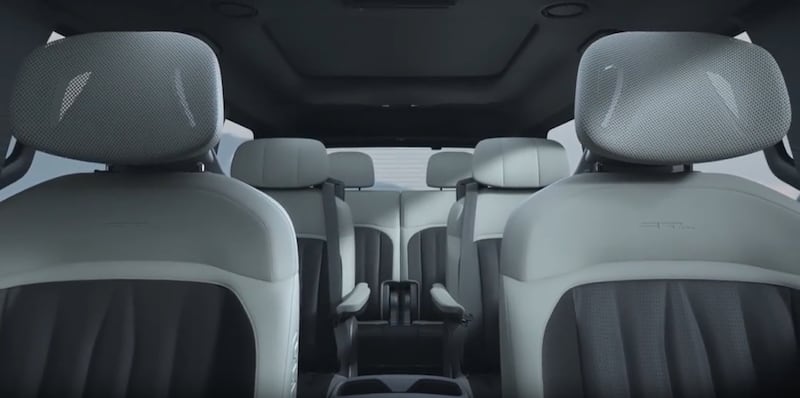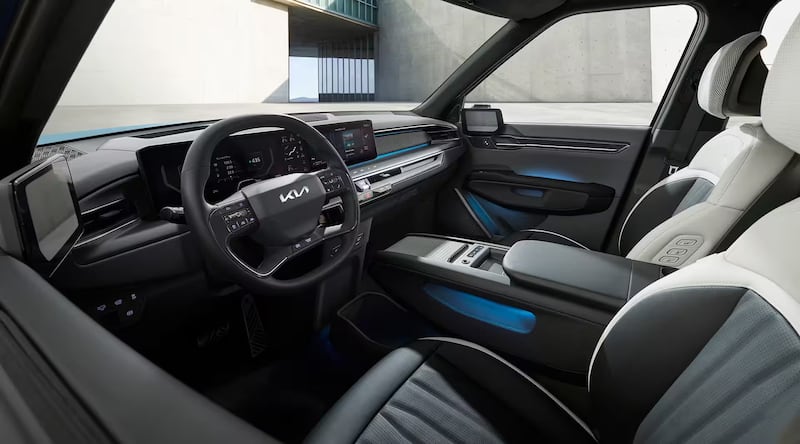Kia’s new all-electric EV9 seven-seat SUV lands in Ireland this November with premium players in its sights.
Pitched as the Korean brand’s new flagship model, it’s a striking US-designed SUV that’s more spacious than the current Sorrento and, Kia estimates, will deliver over 540km in range from its big 99.8kWh battery pack.
Pricing will be key, but if Kia can deliver this with a relatively affordable price point (relative to other big EVs like the upcoming Volvo EX90) then it should be a big draw for well-heeled family buyers.
That will further establish the brand on the driveways and garages of buyers who previously would have opted for premium German cars.
Ireland’s far-right activists don’t want what they say they want
Black Lives Matter was huge, impactful and momentous. Why did it collapse?
Graham Norton: ‘Angry people want you to lose rights. I hope young gay people are up for the fight’
Moving to Australia: ‘I would have had a very fixed life in Ireland. I feel very light here’
Can the EV9 do for Kia what the Santa Fe did for its sister brand Hyundai? Certainly, the potential is there.
Kia’s global head of design, Lebanese-born Canadian Karim Habib, says he is proud of the way the production car so closely resembles the concept.
While the concept looked like it was destined for the Ukrainian front line, in the production metal, the EV9 is not as imposing as it appears in photos. Measuring in at more than five metres, and 1.9 metres tall, it’s no shrinking violet, but the bonnet is lower to the ground compared to other big SUVs. A slightly larger glasshouse – the middle bit with the windows – means the EV9 doesn’t look as stark as some big SUVs, while it also gives the cabin a greater sense of airiness and space.
While the big wheelbase of 3.5 metres creates room for the battery in the floor pan, there is very little overhang once the wheels are accommodated. That should mean decent handling.
That pays off in the cabin, which is roomy, even in the third row. Share out the legroom between the two rear rows and you can accommodate two reasonably sized adults back there, thanks in part to the ability to recline the rear of those two jump seats as well. Kia will be offering this SUV with either six or seven seats, but it would seem pointless to opt for the former.
Up front, the dash is dominated by a set of screens: a 12.3-inch display for the driver; a 5-inch screen for air-con controls and a further 12.3-inch infotainment display. Below this are a set of smart haptic buttons for some fundamental controls, along with a volume wheel. It’s a neat and clean layout, that is further helped by the lack of a central console between driver and passenger.

Boot space is generous, with 730 litres available with the five-seat format, 330 litres when the third row is in use and 2,300 litres with all the back seats folded down. There’s also another spacious cubbyhole under the bonnet; either 52 or 92 litres depending on whether the version of the car is all-wheel or rear-wheel drive. Both versions come with a 99.8kWh battery pack.
The rear-wheel drive version has a 150kW motor which is capable of a maximum torque output of 350 Nm and a 0-100km/h time of 9.4 seconds. It has an all-electric driving range of up to 541km, according to the Worldwide Harmonised Light Vehicles Test Procedure (WLTP).
The all-wheel drive variation is powered by twin 141kW electric motors with maximum torque of 250 Nm from the front and 350 Nm from the rear for the regular version. The GT Line model will get an extra 100Nm of torque at the front. The end result is a 0-100kmh time of 6.0 seconds for the regular all-wheel drive and 5.3 seconds for the GT-line. Kia says the all-wheel drive versions will deliver an estimated WLTP all-electric driving range of up to 497km.

The EV9 is capable of 800-volt ultra-fast charging, which means 15 minutes of charging at a powerful charge point results in an up to 239km of all-electric driving range for the RWD version and up to 219km for the AWD version.
[ How to make a smaller Volvo as safe as a big oneOpens in new window ]
It is also capable of what’s called bidirectional charging. That means you can use the car’s battery pack to power other electric devices. Kia claims a fully charged EV9 battery could power a household for between five and 10 days. The car is also capable of new Vehicle-to-Grid (V2G) support. This nascent project involves using EVs to store excess energy created by renewables like wind and solar, then allowing the grid to take this power back when needed. If successful, this could be a game-changer for the electricity supply market.
Closer to market, Kia is preparing the way for selling software services to buyers through its online Kia Connect store. The idea is to allow owners to subscribe to optional services in the future rather than purchase them at the start.
It’s a tricky path, one that drew a lot of criticism of BMW when it moved to subscription services for some in-car functions. However, Kia is adamant its offerings will be options like streaming services or, in some countries, extra power boosts. Meanwhile, executives say the over-the-air updates will keep the EV9 in line with tech developments in the industry.
As to the future, Kia is planning 15 new EV models by 2027, 11 of which will land in Ireland. The ambition is that across Europe, 70.9 per cent of its new car sales by 2030 will be all-electric.
Next up is likely to be the EV5, an electric alternative to the current Sportage, and the EV4, which will target the likes of the Volvo CX40 and Mercedes EQA.
[ Peugeot relaunches 2008 with longer-range EV model and new hybrid versionOpens in new window ]
The company is also working towards great autonomous driving, with hands-free driving available on the new EV9 where local laws allow. The only car to feature two Lidar cameras working in combination with 15 other sensors and microphones, the EV9 will let the driver leave it entirely to the car to manage itself in highway traffic at speeds up to 55km/h. Unfortunately, such capabilities are only legal in Germany, and a few US and Asian states, but the tech is ready to roll out on EV9s when governments give the go-ahead.
Given Kia’s global reach, the EV9 seems a better fit to the motoring landscape of the US market than the tight city streets of Europe, but the shortage of seven-seater EVs will lure many Irish buyers to take a look. The overall fit and finish of the car, which is impressive, may well persuade them to make the move to the Korean brand. Price will be key, but if Kia can deliver this car for close to €75,000 then it should be a cause of concern for premium competitors.



